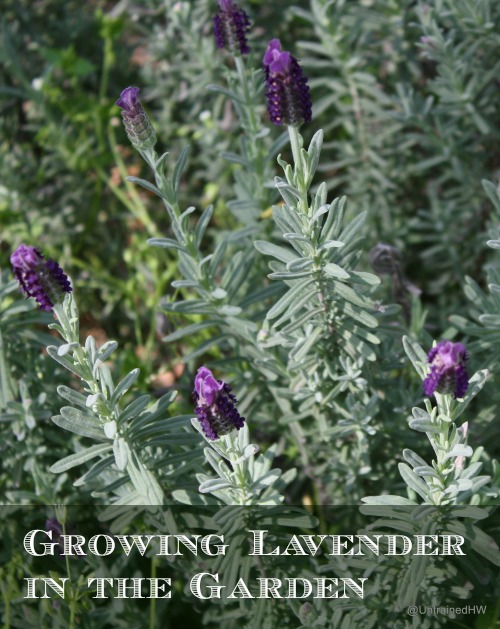Here’s an in-depth profile of a favorite herb plant: lavender. Learn why this herb is prized in the garden and how to select and care for this popular edible perennial. With a famous scent, and a delightful, cottage-garden look in the landscape, perennial lavender plants will earn a place in any herb gardener’s heart.

Cultivation Information and How to Grow Lavender Plants
Botanical Name – The lavender plant goes by the scientific name, Lavendula spp.
Hardiness Zone – Lavender is hardy in zones 5-10, depending on variety.
Bloom Time and Color – The lavender plant will produce long-lasting, fragrant flowers in the summer months. The purple-blue blooms, for which lavender is named, will grow on sturdy stalks up to 4′ tall depending on the variety. Lavender flower pollen is mildly allergenic to some people, although this is rare. Bees and butterflies find the aromatic blooms attractive.
Plant Category Type – Lavender is an herbaceous perennial plant, though some varieties are treated as annuals.
Folliage – The foliage of the lavender plant is semi-evergreen and has a fine texture, making it an excellent choice to blend with other plants in a mixed border combination planting. Lavender has silvery-green foliage that is also aromatic.
Growth Habit – Lavender has an upright, bushy growth habit and is usually as wide as it is tall.
Using Lavender Plants in the Garden
Preferred Conditions – Lavender thrives in well-drained soil and full sun. It can handle periods of semi-drought once fully established, making it a nice herb choice for a “water-wise” garden or in arid areas. Lavender tolerates sandy soil conditions as long as the drainage is good.
Maintenance– Very little pruning is needed to keep lavender looking good. Still, the woody-stemmed plant will benefit from gentle shaping, which can be done in the spring. In many herb gardens, lavender is the neglected “wild child” and manages to flourish with this type of care. In fact, in the book Southern Herb Growing, the authors make this comment regarding care of the variety Lavender angustifolia: “We recommend planting them in the driest area you have, in full sun, and neglecting them a lot.”
Propagation Methods – Lavender can be started from seed indoors and brought outside when it has more than one true stem. It is also propagated through cuttings or layering.
Companion Plants – Choose companion plants for lavender, whose shape and structure contrast nicely, such as Allium or Butterfly Weed. Other popular plants to partner with lavenders are scented plants such as Roses, Rosemary, or Daylillies.
Uses in the Garden – With its outstanding fragrance, beautiful blooms, and pleasant silhouette, lavender can be used as a specimen plant, in a large container, or in a variety of other garden situations. A favorite in herb gardens, kitchen, cottage, English heirloom, and cut flower gardens, you can also use it anywhere you want to add some scent along a pathway or near an entrance way. Effective in mass plantings or as a low hedge, as well.

Other Uses of Lavender Herbs
Other Uses – The blooms make great additions to cut flower bouquets, where they can add fragrance to a vase of flowers you bring in the house. Highly prized for its scent, the entire plant is also used commercially to make essential oils and potpourri. Many home growers choose to use them in their own potpourri blends or in home crafts. If you want to dry the flower stalks for everlasting bouquets, wreaths, or other crafts, you’ll want to cut the stalks when the flowers show their color, but before the buds are completely opened.
Lavender is also used in natural health care products, many homemade! Find a recipe here for a milk bath that uses essential oils.
The blossoms, while usually grown for their fragrance, are edible and make a unique garnish for salads. Often used in jellies, sauces, and herb vinegars, it is the “secret spice” that gives food in Provence its unusual flavor.
Lavender Cultivars and Varieties for the Garden Landscape
- Lavendula angustifolia – Common or English Lavender: This is the most common variety of lavender, and it grows 2-3’ tall and wide. It has the classic lavender colored blossoms and is the easiest to grow for beginners. Hardy to zone 5, it doesn’t always fare as well along the Gulf Coast, where it must fight the muggy summers.
- L. angustifolia ‘Munstead’ – Dwarf English Lavender: This variety has paler colored blooms and only grows to 12-18″ tall and wide. Great for a miniature garden or in a container. I used mine for edging a more narrow flower bed and had plenty of room to plant other perennials behind it.
- L. angustifolia ‘Hidcote’ – Hidcote Lavender: The mid-sized lavender of this variety has deep purple blooms and grows 18″ tall and wide.
- Lavendula dentata – French Lavender: Suitable for humid southern gardens, this lavender is not as cold hardy and would need to be lifted and brought indoors before a frost. Long-lasting flowers on a plant that seems to be constantly in bloom make this a favorite for warm-climate gardeners.
Whatever variety you choose to plant in your garden, you are sure to be pleased with the care-free nature of this plant, as well as its generous fragrance.






